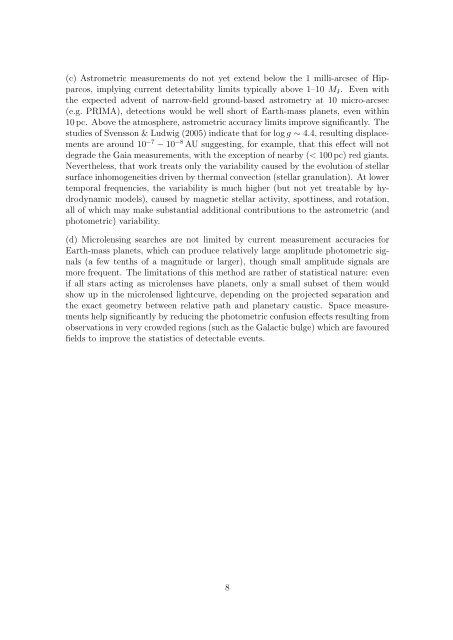Report - School of Physics
Report - School of Physics
Report - School of Physics
Create successful ePaper yourself
Turn your PDF publications into a flip-book with our unique Google optimized e-Paper software.
(c) Astrometric measurements do not yet extend below the 1 milli-arcsec <strong>of</strong> Hipparcos,<br />
implying current detectability limits typically above 1–10 M J . Even with<br />
the expected advent <strong>of</strong> narrow-field ground-based astrometry at 10 micro-arcsec<br />
(e.g. PRIMA), detections would be well short <strong>of</strong> Earth-mass planets, even within<br />
10 pc. Above the atmosphere, astrometric accuracy limits improve significantly. The<br />
studies <strong>of</strong> Svensson & Ludwig (2005) indicate that for log g ∼ 4.4, resulting displacements<br />
are around 10 −7 − 10 −8 AU suggesting, for example, that this effect will not<br />
degrade the Gaia measurements, with the exception <strong>of</strong> nearby (< 100 pc) red giants.<br />
Nevertheless, that work treats only the variability caused by the evolution <strong>of</strong> stellar<br />
surface inhomogeneities driven by thermal convection (stellar granulation). At lower<br />
temporal frequencies, the variability is much higher (but not yet treatable by hydrodynamic<br />
models), caused by magnetic stellar activity, spottiness, and rotation,<br />
all <strong>of</strong> which may make substantial additional contributions to the astrometric (and<br />
photometric) variability.<br />
(d) Microlensing searches are not limited by current measurement accuracies for<br />
Earth-mass planets, which can produce relatively large amplitude photometric signals<br />
(a few tenths <strong>of</strong> a magnitude or larger), though small amplitude signals are<br />
more frequent. The limitations <strong>of</strong> this method are rather <strong>of</strong> statistical nature: even<br />
if all stars acting as microlenses have planets, only a small subset <strong>of</strong> them would<br />
show up in the microlensed lightcurve, depending on the projected separation and<br />
the exact geometry between relative path and planetary caustic. Space measurements<br />
help significantly by reducing the photometric confusion effects resulting from<br />
observations in very crowded regions (such as the Galactic bulge) which are favoured<br />
fields to improve the statistics <strong>of</strong> detectable events.<br />
8
















